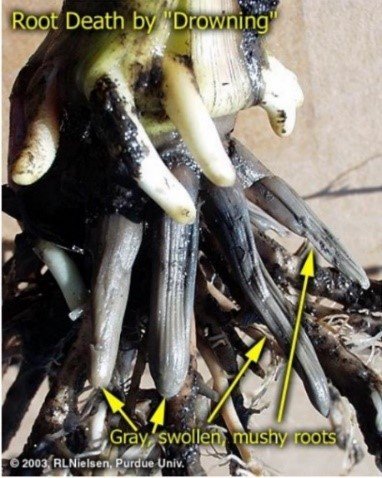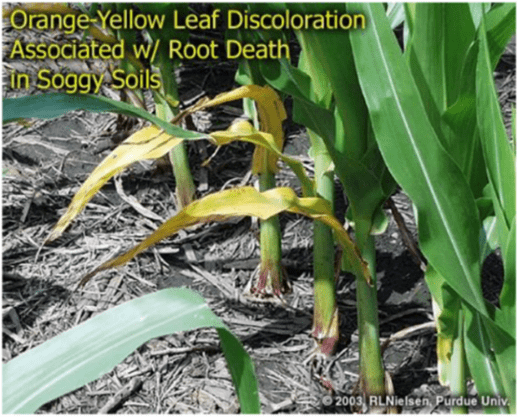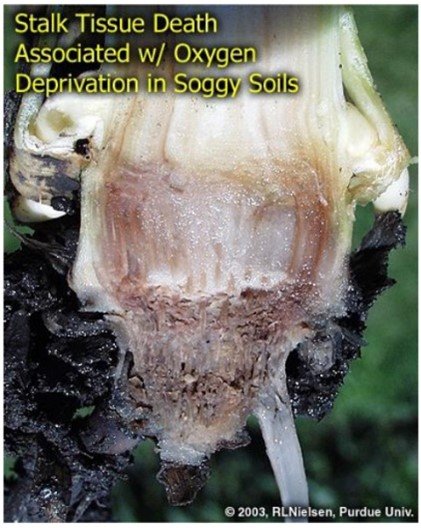
Technical Hub
Late season flooding of maize
Effect of flooding on maize crops
Flooding damage to maize is highly dependent on the plants stage of development, the length of the flooding period and the soil-air temperatures.
Maize is affected most by flooding in the early stages of growth. Younger maize plants die if submerged in water for more than a few days, especially in warmer weather conditions. If air temperatures are high, death may occur in more quickly as plant processes are sped up and the need for a supply of oxygen to the roots is high. In cooler weather, submerged plants may survive for much longer.
As plants develop beyond the V6 growth stage (plant with six true leaves) they are less susceptible to flooding damage. Rapid stalk elongation elevates the plants growing point above the soil surface and away from the direct stress of flooded soils. In addition, an older crop's root system is larger and consequently the crop can tolerate some root death without dying or dramatic stunting.
Grain yield loss due to flooding can be substantial when plants are submerged immediately before and during the tasseling and silking period.
Once kernels have set they are susceptible to abortion when stressed prior to the late dough or early dent development stage. The younger the stage of kernel development, the more prone to abortion. Tip kernels on the ear are the most susceptible because they are generally the last to be fertilised and less competitive for nutrients than kernels closer to the butt of the cob. However, in extreme flooding situations, butt kernels can also abort.
Ears affected by kernel abortion can become “spongy”. Crops that have had the ears covered with water are also particularly prone to cob rots and premature kernel sprouting. Although maize plants may not be killed outright by the oxygen deficiency and the carbon dioxide toxicity caused by flooding, root uptake of nutrients may be severely reduced. This may result in deficiencies of nitrogen and other nutrients during the grain fill period.
Figure 1: Root death from flooding (Nielsen, 2003)

Within a few days of a significant ponding event the lowest leaf of the plant often turns a vibrant orange - yellow. It is thought that this is a response to the initial stages of root death that occurs under saturated soil conditions. Symptoms will appear on plants whether they were ponded or simply stressed with "soggy" soils. The symptom does not appear to be caused by true nitrogen deficiency because the rest of the leaves remain green. Impacted leaves eventually die and completely and wither away (Nielsen, 2003).
Figure 2: Leaf firing in flooded maize (Nielsen, 2003)

In flooded fields the potential for increased levels of root rots will be greater due to root death. Mud and dirt covering the plant will reduce photosynthesis and may result in the plant cannibalising nutrients from the stem increasing the risk of stem rot.
Bacterial stalk rot can occur following flooding. It is characterised as a tan to dark brown, water-soaked, soft or slimy disintegration of pith tissues at a single internode. Affected stalks suddenly collapse and are usually twisted. The tips of the uppermost leaves often wilt, followed by a slimy soft rot at the base of the whorl. The decay spreads rapidly downward until the affected plants collapse. Lodged plants usually have a foul odour. (Reference: RPD No 200. Corn Stalk Rots, University of Illinois).
Figure 3: Stalk Tissue Death from Flooding (Nielsen, 2003)

Bacterial ear rot is caused by one of several species of soft rot bacteria that live on plant debris in soil. During periods of high rainfall, flooding or poor drainage, bacteria are splashed onto plants and infect susceptible tissue.
What to do after flooding
Maize growers should inspect flood damaged crops 5-7 days after the water has receded.
Check the colour of the growing point. It will be firm and white and cream if healthy. If the growing point tissue is darkened and soft (see Figure 3) it has been damaged.
Because flooding may cause root death as well as increasing the risk of stalk and root rots, standability may be an issue in flooded maize crops. Check the stability of plants and watch for any signs of root or stalk rots. Monitor the cob thoroughly to ascertain the amount of cob damage.
Crops that show any symptoms of cob, root or stalk rots or badly lodged crops should be earmarked for silage and harvested as soon as possible at the appropriate drymatter percentage.
Making maize silage from flooded crops
Do not be tempted to harvest earlier than 30% drymatter unless the crop is dying. Harvesting at low drymatter increases the risk of a poor quality fermentation and subsequent silage quality and animal intake issues.
Floods contaminate crops with large amounts of organic debris resulting in high levels of yeast and mold spores and undesirable bacteria that will enter the stack with the crop. Maize silage made from flooded crops is therefore particularly susceptible to poor aerobic stability. (Aerobic stability is a measure of how long silage remains cool and retains its quality after the stack is opened at feed-out time). The prevention of aerobic stability problems requires critical attention to ideal silage management practices such as packing, sealing and maintaining proper feed-out rates.
The use of a Pioneer® brand inoculant that improves aerobic stability (i.e. 11C33RR) is highly recommended.
References
Integrated Pest Management. 2002. Corn Stalk Rots. University of Illinois Extension.
Lauer, J. 2001. How Does Flooding Affect Corn Yield? Wisconsin Crop Manager. University of Wisconsin.
Ministry of Agriculture and Food in Canada. 2002. Corn: Other Problems Affecting Corn Production.
Nielsen, R. Flood or Ponding Damage to Corn Late in the Growing Season. 2022. http://www.kingcorn.org/news/timeless/FloodDamageLateCorn.html
Nielsen, R. 2000. Flooding & Ponding: How Long Can Corn Tolerate “Wet Feet”?. Purdue University.
